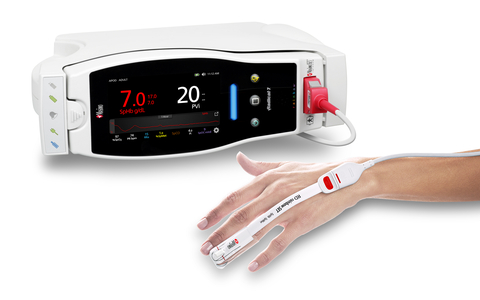New Study Finds That Noninvasive and Continuous Hemoglobin Improved Transfusion Management and Outcomes in Pediatric Patients
Masimo (NASDAQ: MASI) announced findings from a study indicating that children monitored with SpHb® experience fewer blood transfusions, less bleeding, and shorter ICU stays during fronto-orbital advancement surgery. The study, published in the Journal of Clinical Monitoring and Computing, analyzed data from 42 pediatric patients, revealing that the SpHb monitoring group had significantly lower intraoperative packed red blood cell transfusion (136.3 mL vs. 181.5 mL, p = 0.015), less postoperative surgical site drainage, and shorter ICU stays (37.1 hours vs. 64.8 hours, p < 0.001).
- Lower intraoperative PRBC transfusion: 136.3 mL vs 181.5 mL (p = 0.015)
- Reduced postoperative surgical site drainage: 125.3 mL vs 185.8 mL (p = 0.013)
- Shorter postoperative ICU stay: 37.1 hours vs 64.8 hours (p < 0.001)
- None.
Children Monitored with Masimo SpHb® Had Less Blood Transfusion, Less Bleeding, and Shorter ICU Stays

Masimo Radical-7® with SpHb® (Photo: Business Wire)
Noting the frequency of significant hemorrhage during craniofacial reconstruction surgery, and the importance of an adequate patient blood management (PBM) policy during such surgery, the researchers sought to determine whether PBM that included noninvasive and continuous hemoglobin monitoring might improve transfusion management and outcomes for children undergoing frontal advancement surgery. For their retrospective, case-control study, they collected data for 42 pediatric patients (average age 8.6 months ± 3.9 months) with plagiocephaly or trigonocephaly who underwent surgery between 2018 and 2021, dividing them into a group of 16 patients whose perioperative PBM included noninvasive, continuous hemoglobin monitoring (SpHb group), and 26 patients who were managed conventionally (control group). The SpHb group’s hemoglobin was intraoperatively monitored using SpHb on Masimo Radical-7® Pulse CO-Oximeters®.
The researchers found that patients in the SpHb group had significantly lower intraoperative PRBC transfusion (136.3 mL ± 40.1 mL vs. 181.5 mL ± 74.8 mL, p = 0.015), less postoperative surgical site drainage (125.3 mL ± 47.7 mL vs. 185.8 mL ± 97.6 mL, p = 0.013), and shorter postoperative ICU stay (37.1 hours ± 12.0 hours vs. 64.8 hours ± 24.9 hours, p < 0.001) than patients in the control group.
The investigators concluded, “SpHb measurement in pediatric craniofacial surgery for craniosynostosis is a safe, noninvasive tool to monitor Hb values and help transfusion decision-making, when used keeping in mind bias and inaccuracies of the device. Patients with continuous SpHb monitoring had decreased intraoperative PRBC transfusions, reduced postoperative surgical site bleeding, and shorter postoperative ICU stay.”
This study adds outcomes evidence for pediatric patients to the growing literature on the value of continuous hemoglobin monitoring with SpHb. In adults, SpHb, as part of PBM programs, has been found to improve outcomes in both high- and low-blood loss surgeries, such as reducing the percentage of patients receiving transfusions,2 reducing the units of red blood cells transfused per patient,3-5 reducing the time to transfusion,6 reducing costs,7 and even reducing mortality 30 and 90 days after surgery by
SpHb is not intended to replace laboratory blood testing. Clinical decisions regarding red blood cell transfusions should be based on the clinician’s judgment considering, among other factors, patient condition, continuous SpHb monitoring, and laboratory diagnostic tests using blood samples.
@Masimo | #Masimo
About Masimo
ORi and RPVi have not received FDA 510(k) clearance and are not available for sale in
References
-
Saracoglu A, Abdullayez R, Sakar M, Sacak B, Incekoy F, Aykac Z. Continuous hemoglobin measurement during frontal advancement operations can improve patient outcomes. J Clin Mon Comp.
7 Mar 2022 . https://doi.org/10.1007/s10877-022-00813-5. - Ehrenfeld JM et al. Continuous Non-invasive Hemoglobin Monitoring during Orthopedic Surgery: A Randomized Trial. J Blood Disorders Transf. 2014. 5:9. 2.
-
Awada WN et al. Continuous and noninvasive hemoglobin monitoring reduces red blood cell transfusion during neurosurgery: a prospective cohort study. J Clin Monit Comput. 2015
Feb 4 . -
Imaizumi et al. Continuous and noninvasive hemoglobin monitoring may reduce excessive intraoperative RBC transfusion. Proceedings from the 16th
World Congress of Anaesthesiologists ,Hong Kong . Abstract #PR607. - Merolle L, Marraccini C, Di Bartolomeo E, Montella M, Pertinhez T, Baricchi R, Bonini A. Postoperative patient blood management: transfusion appropriateness in cancer patients. Blood Transfus 2020; 18: 359-65 DOI 10.2450/2020.0048-20.
- Kamal AM et al. The Value of Continuous Noninvasive Hemoglobin Monitoring in Intraoperative Blood Transfusion Practice During Abdominal Cancer Surgery. Open J Anesth. 2016;13-19.
- Ribed-Sánchez B et al. Economic Analysis of the Reduction of Blood Transfusions during Surgical Procedures While Continuous Hemoglobin Monitoring is Used. Sensors. 2018, 18, 1367; doi:10.3390/s18051367.
-
Cros J et al. Continuous hemoglobin and plethysmography variability index monitoring can modify blood transfusion practice and is associated with lower mortality. J Clin Monit Comp.
3 Aug 2019 . https://doi.org/10.1007/s10877-019-00367-z. - Published clinical studies on pulse oximetry and the benefits of Masimo SET® can be found on our website at http://www.masimo.com. Comparative studies include independent and objective studies which are comprised of abstracts presented at scientific meetings and peer-reviewed journal articles.
- Castillo A et al. Prevention of Retinopathy of Prematurity in Preterm Infants through Changes in Clinical Practice and SpO2 Technology. Acta Paediatr. 2011 Feb;100(2):188-92.
- de-Wahl Granelli A et al. Impact of pulse oximetry screening on the detection of duct dependent congenital heart disease: a Swedish prospective screening study in 39,821 newborns. BMJ. 2009;Jan 8;338.
- Taenzer A et al. Impact of pulse oximetry surveillance on rescue events and intensive care unit transfers: a before-and-after concurrence study. Anesthesiology. 2010:112(2):282-287.
- Taenzer A et al. Postoperative Monitoring – The Dartmouth Experience. Anesthesia Patient Safety Foundation Newsletter. Spring-Summer 2012.
-
McGrath S et al. Surveillance Monitoring Management for General Care Units: Strategy, Design, and Implementation.
The Joint Commission Journal on Quality and Patient Safety . 2016 Jul;42(7):293-302. - McGrath S et al. Inpatient Respiratory Arrest Associated With Sedative and Analgesic Medications: Impact of Continuous Monitoring on Patient Mortality and Severe Morbidity. J Patient Saf. 2020 14 Mar. DOI: 10.1097/PTS.0000000000000696.
- Estimate: Masimo data on file.
- http://health.usnews.com/health-care/best-hospitals/articles/best-hospitals-honor-roll-and-overview.
Forward-Looking Statements
This press release includes forward-looking statements as defined in Section 27A of the Securities Act of 1933 and Section 21E of the Securities Exchange Act of 1934, in connection with the Private Securities Litigation Reform Act of 1995. These forward-looking statements include, among others, statements regarding the potential effectiveness of Masimo SpHb®. These forward-looking statements are based on current expectations about future events affecting us and are subject to risks and uncertainties, all of which are difficult to predict and many of which are beyond our control and could cause our actual results to differ materially and adversely from those expressed in our forward-looking statements as a result of various risk factors, including, but not limited to: risks related to our assumptions regarding the repeatability of clinical results; risks related to our belief that Masimo's unique noninvasive measurement technologies, including SpHb, contribute to positive clinical outcomes and patient safety; risks that the researchers’ conclusions and findings may be inaccurate; risks related to our belief that Masimo noninvasive medical breakthroughs provide cost-effective solutions and unique advantages; risks related to COVID-19; as well as other factors discussed in the "Risk Factors" section of our most recent reports filed with the
View source version on businesswire.com: https://www.businesswire.com/news/home/20220327005075/en/
Masimo
949-396-3376
elamb@masimo.com
Source: Masimo
FAQ
What were the findings of the recent Masimo study on pediatric patients?
What is the significance of continuous hemoglobin monitoring in surgeries?
Where was the Masimo study published?
What is the stock symbol for Masimo?







